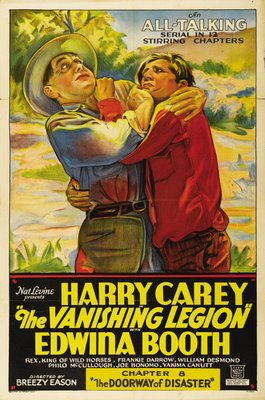
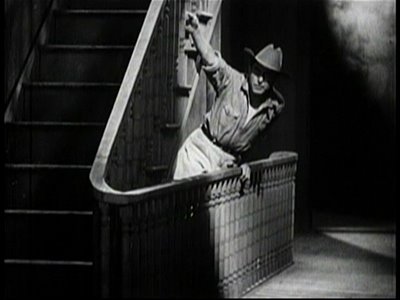 Three Cheers For The Vanishing Legion!
Three Cheers For The Vanishing Legion!Endurance levels vary where it comes to movie serials, usually depending on who produced them. There is Republic, a slickest outfit of the lot, certainly a most efficient for its day. Their serials call to mind precise movements of a fine watch. Stuntwork, music, special effects --- all out of the top drawer. If anything, Republic chapter plays are too polished. Then there is Universal and Columbia. These were not companies dedicated to serials, but kept units for manufacturing them, most of output slick and reasonably efficient. Beneath this level, there are the independents and what came of poverty row, a benighted category for those of very little resource, but much resolve. There are those, mere dilettantes, who but casually watch serials, and then ones who dig deepest for what came out of Mascot Pictures, a cheapest, if not a most adventurous, of serial makers. Mascot would not last past the mid-thirties, but they left an imprint that is to this day unmistakable. Their chapter plays exemplify primitivism in movies at least the equal of twelve Edison silent shorts watched end-to-end. I like Mascot serials. I enjoy the sound of horse hooves as they race past prehistoric recording equipment. Scuffling noises during fight scenes have a raw and realistic flavor. Sound effects and dialogue are seldom, if ever, dubbed in. You often hear things clearly not meant to be heard. Lines are muffed or let go altogether. Actors stand and wait for cues not forthcoming. Sometimes stunts go wrong, or else guys don’t mind crashing open roadsters and having wreckage flip over on top of them. You always get the feeling there were people killed on these shows and nobody said anything because these were, after all, fringe productions. Nat Levine was the mastermind behind Mascot serials. He shot The Vanishing Legion in 18 days for three thousand dollars a chapter (with the exception of a lavish opening installment at five thousand). If you can get through all twelve, there’s a G.M.B. (Greenbriar Merit Badge) waiting for you in our lobby …
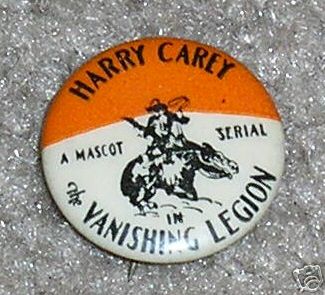

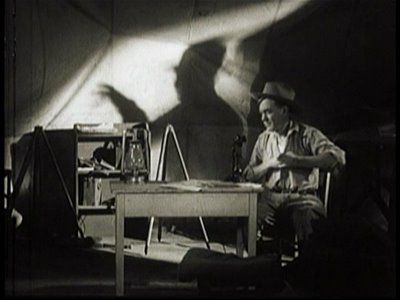
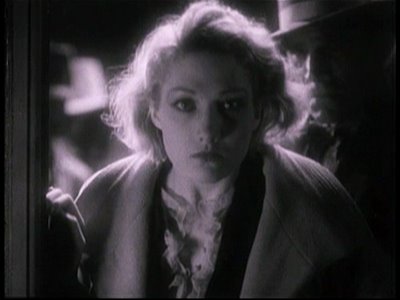
Mascots are the only serials that look as though they were shot in my Grandmother’s backyard. Austere is the operative word here. Harry Carey chases miscreants down streets and through buildings that appear as though they’re still waiting to be wired for electricity. There are no paved roads in this serial, even in the face of its "modern" setting. The town where much of action takes place is devoid of extras. It’s like everyone either died or cleared out. Backgrounds have a look of utter desolation. Object or advantage being fought over has little monetary or spiritual value against such a bleak void. As with so many serials, you lose track of who’s pursuing who, let alone why. The chase becomes an end in itself. Men exist to fall out of windows or be shot at. The alternate Mascot universe never acknowledges ordinary concerns of life. To maintain the pace of a Harry Carey in this show (53 when he made it), you must submit to bullet wounds (Only a scratch, Jimmy), topple off rockbound cliffs (I’ll be all right, Jimmy), or plunge from atop oil derricks (That was a close one, Jimmy!). You can do this sort of thing in the cartoon world of Republic because their serials offered comforting remove from any sort of recognizable reality, while Mascot serials unsettle all the more for suggesting, by obvious lack of studied preparation, that much of this is actually happening to harassed and underpaid cast members. Good God, is that poor Harry being thrown backward down a flight of stairs? Will someone among the threadbare crew drive him to a hospital in the event he really got hurt? The tension these cliffhangers create is too real for comfort. You imagine a secret burial on location for some luckless stuntman with a family back in Oshkosh that hasn’t seen him in eighteen years. Who would ever be the wiser?


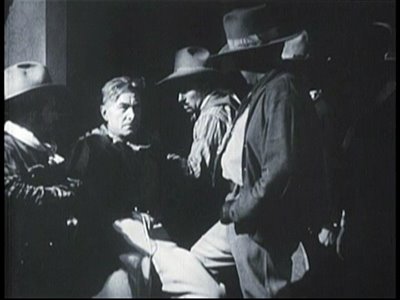
Nat Levine used faded names and anxious beginners. Harry Carey had been around since Biograph days, his kind of westerner having gone out with William S. Hart, and despite a recent success with MGM’s Trader Horn, he couldn’t be choosy. Edwina Booth was another Trader Horn veteran, though her inept dialogue delivery must have given even producer Levine pause. Twelve-year-old Frankie Darro served as audience identification figure and got one thousand dollars for doing this serial, while Rex, King Of The Wild Horses was coming off a series of silent westerns for Hal Roach. Stunt pioneer Yakima Canutt supervised the riskier action, with much footage purloined from features going back ten years. The Vanishing Legion was enlivened by a mystery villain known as The Voice, so-called because we never glimpse his face, at least not before the unmasking in Chapter Twelve. Pre-stardom Boris Karloff supplies the unseen, but oft-heard, presence throughout, a credit sometimes omitted from the actor’s filmography. The Voice commands the titular legion. We’re never briefed as to how he imposes his will upon such a large body of men. Perhaps his sinister intonations are enough to assure loyalty. I’m abashed to admit failure at guessing the identity of Mister Big prior to his reveal (not Karloff, who was used only for spoken passages). Maybe it was inattention on my part, numbing effect of a glacial narrative over twelve seemingly identical chapters. Then why seek more of Mascot? Reasons are variable, few I can sensibly explain, yet something in me longs for The Devil Horse, Mystery Mountain, The Lightning Warrior (Rin-Tin-Tin’s final film!), and all the rest. The only problem, a major one, is the lack of quality DVD’s available. Insofar as that goes, The Vanishing Legion is a remarkable exception. There is a concern known as The Serial Squadron that offers restorations of many chapter play favorites. Their transfer of The Vanishing Legion has by far the best quality of any Mascot serial I’ve seen. Here's hoping they’ll continue mining these obscure treasures.
4 Comments:
A slicker Mascot serial to check out would be "Burn 'Em Up Barnes" with Frankie Darro and Jack Mulhall as Barnes. This title features some incredible action scenes that corresponds with your thoughts about the stuntmen and their safety. Also..."The Galloping Ghost", an earlier title with Red Grange is a real hoot with some bizarre sequences and performances
That actually sounds like fun! I've always enjoyed the low-rent programmers from studios (if you could consider them studios) like PRC, Monogram and the rest. Anyone can shoot a movie when you've got a Metro budget. It takes a real talent to do the same thing for a few thousand.
You may well be right about the odds of some luckless stuntmen going the way of all flesh on these serials. I notice the director is B. Reeves "Breezy" Eason, who was famous for his amazing action scenes...and notorious for not much caring what he had to do to get them. Old-timers told Kevin Brownlow about all the horses that had to be put down while shooting the silent Ben-Hur chariot race, and in the 1936 The Charge of the Light Brigade the carnage is right there on screen, so appalling that it led to legislation to protect animals on the set. (Errol Flynn also wrote in My Wicked, Wicked Ways of a stuntman friend who was killed by his own sword in a horse fall.) And those were at MGM and Warners; what corners might Eason have cut at Mascot?
Didn't Edwina Booth get sleeping sickness filming TRADER HORN?. So how did she make another film right after? Maybe she was ill during the filming of this serial, and that is why her line readings are so bad.
Post a Comment
<< Home